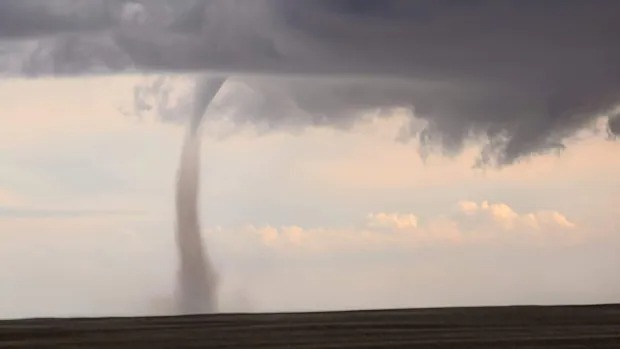Canadian tornadoes are generally weaker and radar upgrades are underway, says Environment and Climate Change Canada.
Canada’s weather agency is falling behind its own tornado warning targets, according to a new report from Occidental College. (Munsch dusty/Twitter)
Rob Been was enjoying an after-dinner nap on his farm northwest of Moose Jaw, Sask. last month when a clap of thunder jolted him awake.
Looking out the window, he saw a ground-spout tornado pass by. The tornado eventually received an EF-0 rating, the lowest possible strength rating for a tornado, but Been found it odd that he received no warning of the impending storm until long after it was gone.
“If it can show up anywhere, you’d like to get some kind of notification rather than 45 minutes later,” Been said.
A recent analysis of tornadoes and tornado warnings in Canada from 2019 to 2021 by the Northern Tornadoes Project (NTP) at Western University in London, Ontario, shows Been’s experience is not out of the ordinary.
In what it calls a “report card” on tornado warning performance, NTP graded Environment and Climate Change Canada (ECCC), the federal agency responsible for issuing weather warnings, in three categories.
The first focused on what fraction of all tornadoes from 2019 to 2021 had a tornado warning. ECCC’s target is 50 percent, but the NTP found that only 26 percent received warnings.
The number increases to 28 percent when only considering tornadoes that occurred within the range of ECCC radars, and 38 percent when only considering tornadoes rated EF-2 and higher.
Environment and Climate Change Canada’s warning system came under scrutiny after a tornado struck Barrie, Ontario, in July 2021. Residents complained of social media that they received a tornado warning after it had already passed (Grant Linton).
The second category scored ECCC’s performance on reaching its goal of issuing a warning at least 10 minutes before a tornado touches down, 60 percent of the time. The NTP found that this only happened 9.5 percent of the time. It increased to 12.5 percent when only tornadoes classified as EF-2 and above are considered.
The final category noted how often a tornado watch preceded a tornado warning in cases of an actual tornado touchdown. ECCC’s goal of a watch issued six hours before a touchdown 80 percent of the time was relaxed to one hour by the NTP, but still resulted in a success rate of only 12.1 percent.
Overall, ECCC scored 37.5 out of 100 points on the NTP report card.
NTP offers recommendations
NTP Executive Director David Sills calls the data “pretty amazing.” He said looking south of the border to the U.S. National Weather Service could improve warning statistics in Canada since the probability of tornado detection there is quite high.
“For every radar in the U.S., there is a full forecast team,” Sills said. “Whereas there are only a handful of (ECCC) offices in all of Canada.”
In addition to training and improvements in forecasting tools, Sills said the number of tornado warnings ECCC issues should be increased, even if a tornado fails to touch down.
“If you don’t issue tornado warnings on storms you think maybe tornadoes, statistically you’ll never get a forecast,” he said.
Sills said this was NTP’s first tornado warning assessment, but plans to do more in the future.
Improvements made, with more to come ECCC says
Joanne St-Coeur, director of the Canadian Weather Service, the weather forecasting arm of Environment and Climate Change Canada, said ECCC has made great strides in alerting the public about tornado storms, such as creating its own weather app and working to update 33. its radar sites.
She said the comparison to U.S. data is somewhat unfair, given Canada’s sparser population and the fact that many tornadoes here are much weaker.
“We are a country more prone to inclement weather during the winter than in the summer months,” St-Coeur said.
St-Coeur said ECCC is looking at ways to detect tornadoes in areas that don’t have radar coverage and plan to change the way tornado warnings are issued to cover smaller, more specific areas.








0 Comments